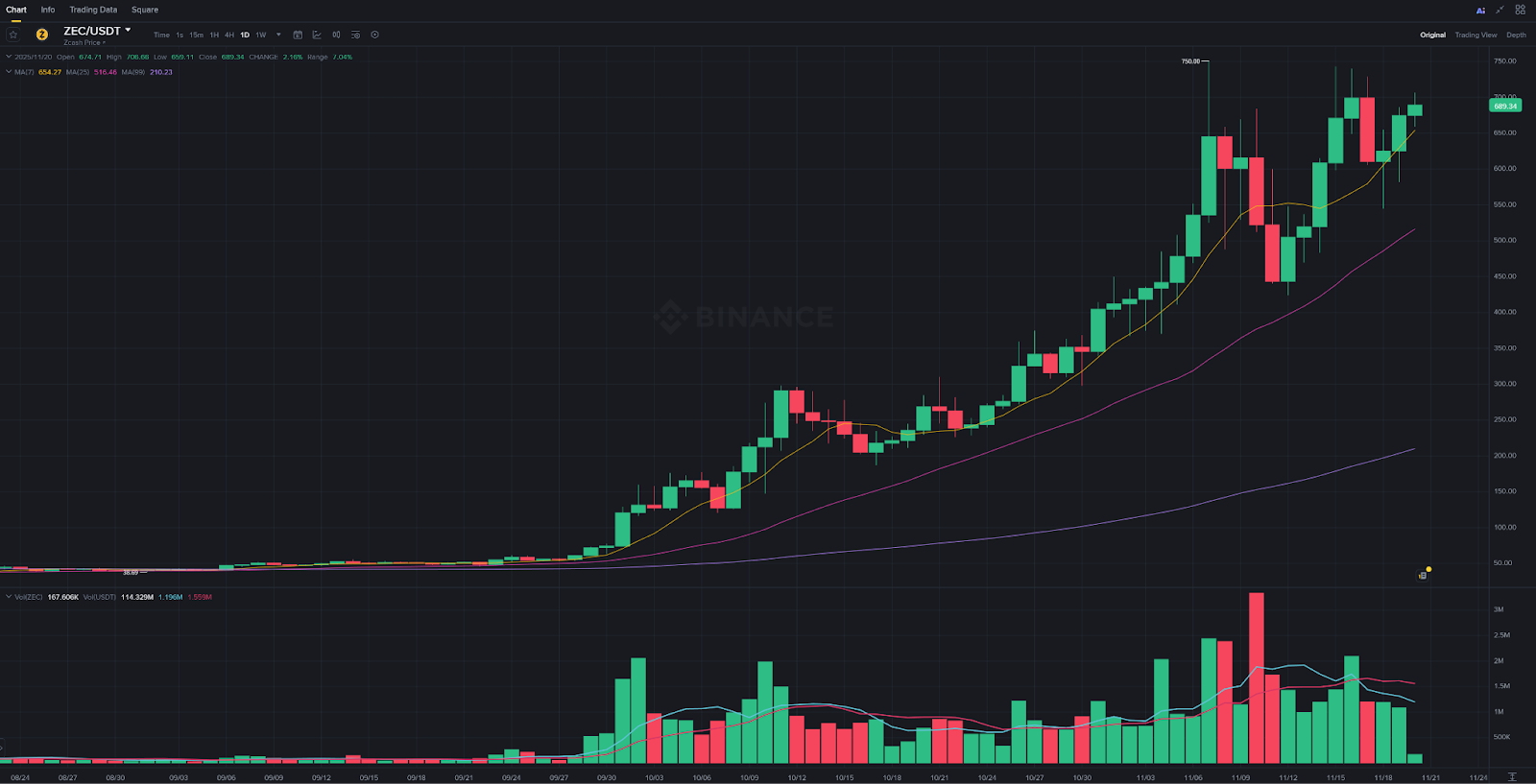The collective anxiety behind ZEC's surge: In the "era of verifiable computing," trust is becoming the scarcest asset.
Zcash suddenly surged. This isn't the first time an older cryptocurrency has suddenly come back into the spotlight, but the timing is particularly significant. In the same week that ZEC rallied, Vitalik released the Trustless Manifesto, and simultaneously, Cloudflare's outage crippled 90% of Web3 projects globally. These three events combined have led the market to reconsider a long-forgotten question: Is trustlessness still valuable?

Cloudflare crashed, and Web3 crashed too.
On November 14th, an internal configuration error at Cloudflare caused 20% of its websites worldwide to be down for over three hours. Platforms like X and OpenAI became inaccessible, and ironically, 90% of the so-called decentralized Web3 projects also went down—because their RPC, front-ends, and APIs were all hosted on Cloudflare. This outage brutally revealed a reality: while blockchain projects claim to be decentralized, they still rely heavily on centralized infrastructure like AWS and Cloudflare in practice. Over the past year, most Rollup Sequencers have been hosted, RPCs have defaulted to third-party service providers, cross-chain bridges depend on a few relays, and even "self-hosted wallets" have been entrusted to exchanges by users. In short, convenience is eroding decentralization.

Source: X
ZEC's surge is a market rebellion against this trend. It represents the most radical and uncompromising ideal of privacy and trustlessness in the past decade—no custodial RPCs, no centralized sequencers, and not even visible transaction details. When the market sees "trustlessness regressing," ZEC is an emotional signal: investors are beginning to reprice trustlessness.
Vitalik's manifesto sets three red lines for the industry.
Vitalik Buterin's "Trustless Manifesto" isn't just a slogan; it draws three red lines for the industry: No critical secrets, No indispensable intermediaries, and No unverifiable outcomes. Violating any of these lines renders your system not a protocol, but a platform; not neutral land, but private property. The question is, how many projects can actually achieve this? Hosted RPC has become the default choice, Rollup sequencers are centrally managed, and cross-chain interoperability relies on a few intermediaries as execution gateways. Centralization didn't happen suddenly; it was quietly eroded through repeated "temporary solutions" and "user experience optimizations." Vitalik's point is: decentralization doesn't last forever, and trustlessness isn't a feature that can be "added later," but the foundation of the system—without it, even the highest TPS is just a castle built on sand.
How can trustlessness be implemented? The answer lies in "verifiable computing".
Relying solely on nodes and P2P networks is no longer sufficient. Modern trustlessness faces the demands of massive computations, complex cross-chain interactions, and high-speed applications, while also ensuring L1-level security. The industry has ultimately reached a conclusion: all execution should not rely on "a middleman running obediently," but rather on verifiable cryptographic proofs. This marks the beginning of the era of verifiable computing. zkSync and Starknet use zero-knowledge proofs to ensure the correctness of L2 execution; EigenLayer allows AVS to inherit Ethereum's security through restaking; Celestia uses data availability sampling to allow light clients to verify data integrity. Their common thread is that they do not require users to "trust" the operators, but rather use mathematics and cryptography to ensure that malicious behavior is caught, making the cost of verification far lower than the cost of re-execution.
Succinct demonstrated trustlessness with "real-time proof".
ZEC represents a set of values, Vitalik's manifesto points to the direction, and Succinct provides the concrete answer to "how to achieve it." In the past few months, this name has been frequently mentioned in the field of verifiable computing because it is pushing trustlessness from theory to engineering reality.
Succinct's newly released SP1 Hypercube zkVM, powered by 16 NVIDIA RTX 5090 GPUs, achieved a landmark breakthrough: in a test of 954 randomly selected Ethereum blocks (block heights 23807739 to 23812008), 99.7% of L1 blocks completed proof generation within 12 seconds, and 95.4% within 10 seconds. This means Ethereum can scale "without trusting any intermediaries"—validators don't need to re-execute blocks, only verify a very short zero-knowledge proof; native rollups can interact with L1 in near real-time without waiting for lengthy finality confirmations; and the entire system relies on no privileged entities or trusted intermediaries at any step. As described by Ethereum Foundation researcher Justin Drake, this will allow Ethereum to scale horizontally to 1 Gigagas per second (approximately 10,000 TPS), which is crucial for serving real-world use cases.

Source: Succinct Labs
More importantly, there's a breakthrough in security. Most zkVMs in the industry still rely on a mathematical assumption called the "Proximity Gap" to ensure security, but when the Ethereum Foundation offered a bounty for research on this assumption, the latest research proved it to be flawed in its most general form. SP1 Hypercube is the first general-purpose hash-based zkVM to completely eliminate reliance on this assumption, directly aligning with the three principles of the Trustless Manifesto: no key secrets, no irreplaceable middlemen, and no unverifiable results. Furthermore, Succinct, in collaboration with Nethermind and the Ethereum Foundation, completed the formal verification of all RISC-V constraints—using mathematical proofs rather than audits or tests to guarantee correctness, a crucial step in realizing trustlessness. Combined with third-party security audits and the newly launched SP1-2FA feature (adding TEE protection via a single line of code), SP1 Hypercube is already providing security for billions of dollars in TVL for leading projects such as Polygon, Celestia, Avail, and Mantle, and will be integrated into OP Succinct and the upcoming Arbitrum integration, improving cost, performance, and security for all customers.
ZEC provided the price signal, Vitalik provided the roadmap, and Succinct provided the answer.
The crypto industry is now at a crossroads: one path leads to higher TPS and a smoother user experience, at the cost of reliance on intermediaries; the other path is more difficult but maintains the core value of blockchain—trustlessness. The rise of ZEC tells us that the market hasn't forgotten its original purpose. Vitalik's manifesto tells us that the future must return to verifiability and the three fundamental principles. Succinct's SP1 Hypercube shows us that this path has already become a deployable reality at the L1 level. Future competition will no longer be a numbers game of TPS, but rather about who can complete the most computation with the least trust cost. On this track, ZEC symbolizes traditional values, Vitalik provides guidance, and Succinct is turning that direction into reality.
- 核心观点:市场重新为去信任化价值定价。
- 关键要素:
- Cloudflare宕机暴露Web3中心化依赖。
- Vitalik发布《Trustless Manifesto》三大原则。
- Succinct实现L1级可验证计算突破。
- 市场影响:推动行业回归去信任化核心价值。
- 时效性标注:中期影响



